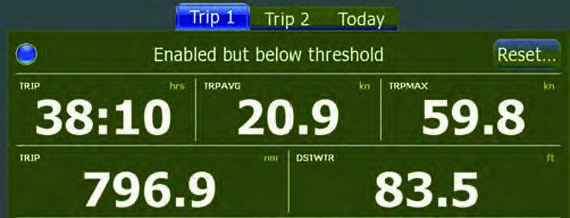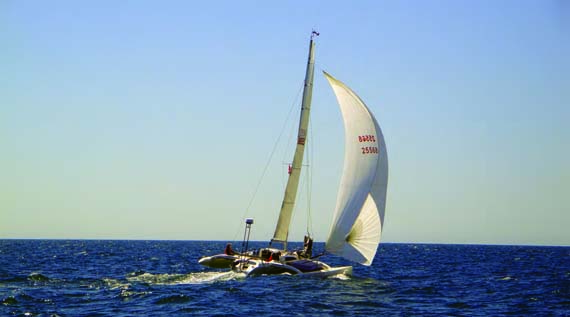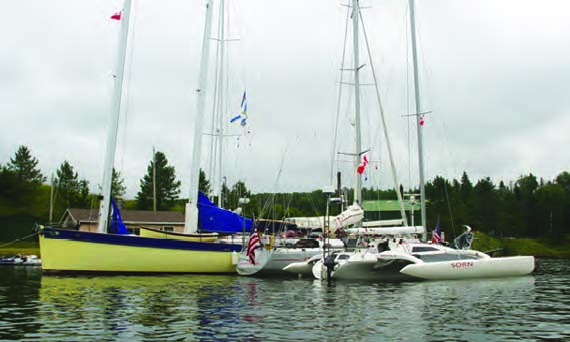by JESSE DEUPREE

The Overland Route to a Bras d’or Cruise
I co-own the F-31 trimaran, Sorn, with Peter McPheeters and Andy Lindsay. We joined up because we like to sail together and have done so for years, and because none of us has the time to fully use Sorn by ourselves. As is typical, only Andy and I were able to make time for the 2012 Cruising Club of America (CCA) cruise to Cape Breton and the Bras d’Or Lakes.
This decision was reached only at the last minute and we only had time for the first part of the cruise. Thanks to Gretchen McCurdy and her team for allowing us a last minute entry – everyone could not have been more hospitable and helpful. The speed of our boat makes these decisions possible. We wanted to be in Baddeck, Nova Scotia by July 19 and our earliest possible departure from Portland, Maine, was on July 18. Fortunately, we had ideal conditions and as our plotter screen shot shows, we made the 797-mile trip in 38 hours at an average speed just under 21 knots. Our maximum speed of 59.8 knots came on a downhill stretch of the Maine Turnpike – little multihulls can be fast, especially when pulled by a powerful truck.
We launched at the Bras d’Or Yacht Club, in Baddeck, whose staff and officers gave welcome assistance. Our plan was to exit via St. Peter’s Canal on our way to the opening cruise event in Louisbourg on the outer Cape Breton coast, and return to the lakes via the Great Bras d’Or channel. We headed south through the lakes on July 20, spending a quiet night at Marble Mountain, way up behind the spit, then transiting the lock at St. Peter’s Canal and spending the next night tied to the canal bulkhead. We saw other CCA boats following the same schedule and noted that several members would be leaving their boats in the lake and taking cars to Louisbourg – essentially the opposite approach of the one we had taken, but one that in hindsight made a lot of sense, given the weather and the nature of Louisbourg Harbor.
On July 22, we headed for Louisbourg on a lovely sunny day in a building southwest breeze. The favorable wind let us make short work of the 40 miles between Point Michaud and Louisbourg under spinnaker, trading pictures with Truman Casner and crew on Astral. Sorn put on a good show, as we had several 17-knot bursts.

Sorn in perfect form Photo courtesy of Jesse Deupree
Upon arriving outside Louisbourg Harbor, we put on the kind of show one hopes no one sees, as I mistakenly pulled the spinnaker halyard clutch for the douse ahead of the tack line. We managed six knots in reverse a few times and got outboard grease on the spinnaker as we wrestled the sail on board, but only our pride was damaged and the only witnesses were Jim Evans and David James on Nellie Lamb. To date, no incriminating photos have surfaced.
Louisbourg was full of CCA boats. The head of the harbor where we could tuck up out of the wind is near the historic fortress and anchoring there is forbidden, so we powered to the bottom of the harbor where we figured to find room in shallow water to swing. Multihulls can sail at anchor in a breeze, and the forecast called for plenty of wind over the next several days. Unfortunately, the wind had plenty of fetch at the bottom end of the harbor and conditions were not ideal for us. In fact, many of the bigger CCA boats looked uncomfortable as well. We dragged immediately after setting our first anchor (a Bruce) – before we could get our second (a Fortress) out. Our progress getting out of the shallows using our outboard in reverse was painfully slow, despite Andy’s valiant efforts to row the anchor to windward using our inflatable dinghy. Thankfully, a local fishing boat offered a pull and dropped our second anchor for us in deeper water; then we were finally holding.
I’m uncomfortable anchoring after I’ve dragged. The forecast breeze made me unhappy with the prospect of leaving our boat unattended during the scheduled visit to the fort the next day, so I was quick to accept Evans Starzinger’s generous offer to tie up to his 47-foot Van De Stadt sloop, Hawk. He was confident he would not feel our 4,500-pound weight tied to his stern like a dinghy, and after helping him move Hawk a little ahead in preparation, I was comfortable with his ground tackle as well. There is a time and a place for a big anchor, and he certainly had one.
Our Fortress anchor – probably confused at my conflicting demands to stick firmly on the bottom when dropped and yet come up easily when pulled, and possibly upset by epithets that might have been used by me while issuing these demands – decided that staying on the bottom was its best choice of action. We had no choice but to buoy the rode and leave it there for later retrieval. We spent a comfortable night astern of Hawk, and during a brief lull the next morning, made our way to the dock with permission of the harbormaster. He also ran a go-kart track as well as what we determined to be the top breakfast spot in town.
I began looking for someone to dive on our anchor, and finally entered a fish plant office where the people debated who to call. They eventually put me on the phone with their first choice, Jeff. In one of those coincidences that are part of what makes cruising memorable, Jeff was one of the fishermen who had helped us the day before. Thus we could meet and properly thank him for assisting us twice. I watched from shore as he struggled to pull our anchor off the bottom with the winch on his fishing boat. The cause of the struggle became clear when we saw a length of enormous chain the anchor flukes had slipped under. We could have lain to that anchor in comfort and safety in any normal wind, and Hawk could have probably tied up to our stern as well. Jeff’s efforts to refuse recompense were genuine, if futile.
Throughout our time in Cape Breton everyone lived up to the reputation they have for friendliness – the people are as welcoming as the scenery is beautiful, and that is saying something.. The CCA event at Fortress Louisbourg was fascinating, and the extra courtesies arranged by our hosts made for a delightful evening. Large cannons were fired near sunset; then we enjoyed a period meal in one of the restaurants that are part of the recreation of this 1745 French fortification.
The next day dawned with the southwest breeze still blowing hard, with 25 to 35 knots forecast. We decided that leaving and heading for the Great Bras d’Or was not the smart choice for us. I figured we would quickly make it around to the entrance, but trying to power into that breeze if it swept down the narrow 20-mile entrance would be beyond the capabilities of our 9.8-horsepower outboard. The great bulk of the fleet left and revealed a harbor empty of moorings. It seems the local folks understand the benefit of sticking to docks and piers in Louisbourg. We had a chance to dine with the crew of several of the smaller CCA boats from Cape Breton who made the same choice to stay.

Farfarer, Grey Ghost and Sorn rafted at Partridge Landing – three very different answers to the question of what makes a good cruising boat © Jesse Deupree
July 25 dawned with a little less wind, but still from the southwest, leaving us a long beat back the way we had come. The seas were large, but a modern multihull goes to windward quite well and the favored port tack gave us a good slant along the coast as the wind and waves didn’t quite match direction. By 1500, we were at Point Michaud and soon after, back in St. Peter’s Canal.
Schedules necessitated a crew change at this point, and Andy was replaced by Phin Sprague, whose around-the-world experience had not included multihulls, but he was game for this brief opportunity. We had two days before the second official event. We had a short first day sail and ended up back in Marble Mountain, as it was perfect shelter in the strong northwesterly. On July 27, we headed for Partridge Landing in Big Harbour near Baddeck, and fell in with Farfarer, Frank Blair’s “fusion schooner,” at the Barra Strait Bridge. We both set sail once through, with us gybing at speed while Farfarer ambled steadily dead downwind. A grey day when we planned on powering turned into a lovely sail, and Phin had his first chance flying an asymmetric chute while driving with a 10-foot extension tiller. Once at Partridge Landing, we took advantage of our shallow and easily reduced draft (daggerboard and dagger rudder) to head up to Surprise Cove for lunch. We tested the width of the passage with our 22-foot beam, but scraped in, then returned to Partridge Landing for the party. The picture shows Farfarer and Grey Ghost, Phil Parish’s ex-OSTAR aluminum sloop inside of us at the dock – three very different answers to the question of what makes a good cruising boat, but boats each of us is happy with.
The party was grand – great food, great music, dancing and singing. Waring Partridge was a thoughtful host, and his beautiful property was both remote and complete with everything needed to host a mass of CCA members. Regretfully, our portion of the cruise had to end after this event, and we made our way to Baddeck the next day where we pulled the boat out of the water. A consultation with a few members produced no definitive answer as to when to strike the burgee, so we kept it up while putting the boat on the trailer with the mast still standing, but lowered the burgee before we dropped the mast.
It is difficult to write anything nice about the drive back to Maine, but I will try. A bearing failure on the trailer put us aground in Port Hawkesbury for 36 hours, and the best restaurant in town was the only restaurant in town – the Irving truck stop. Phin proved an able shipmate in adverse conditions. He managed a field repair to the bearing. That got us to the only place in town capable of rebuilding our axle. Then he directed a field trip to Canso, where we found a fine small museum dedicated to the British expedition that drove the French out of Cape Breton, assisted by Phin’s American forebears. This completed the history lesson we had received in Louisbourg. As always, the pleasure of a friend and able crew outweighs bad food and an unforeseen delay.
My total time on the cruise was less than two weeks, and I expect many members spent more than that just getting to and from Cape Breton. I can only wish for time right now and envy those who have it. We covered a lot of miles, even if the majority was over land. We experienced the natural beauty and wonderful sailing of Cape Breton and the Bras d’Or Lakes. Meeting many CCA members new to us, especially those who call Cape Breton home, proved the best reason to participate – it easy to understand how our club was conjured up in that wonderful location.
Jesse Deupree grew up cruising and racing on the Maine Coast and has never done it enough. About 15 years ago he came under the spell of sailing on more than one hull.
Editor’s note: This article was originally published in the 2013 edition of Voyages, the Cruising Club of America’s (CCA) annual publication, and is reprinted with permission. Special thanks to CCA Commodore Daniel P. Dyer III and Voyages Editors Dale and Doug Bruce.
The Cruising Club of America is an international organization with a membership of 1,250 men and women who have voyaged the oceans for adventure and recreation. Their mission is “to promote cruising by amateurs, to encourage the development of suitable types of cruising craft, to stimulate interest in seamanship, navigation and handling of small vessels, and to gather and keep on file all information which may be of assistance to members in cruising.”
The CCA organizes and runs the biennial Newport Bermuda Race and conducts safety at sea seminars. Their Bonnell Cove Foundation makes grants to non-profit organizations for projects in safety at sea and environmental protection. For more information, visit cruisingclub.org.




